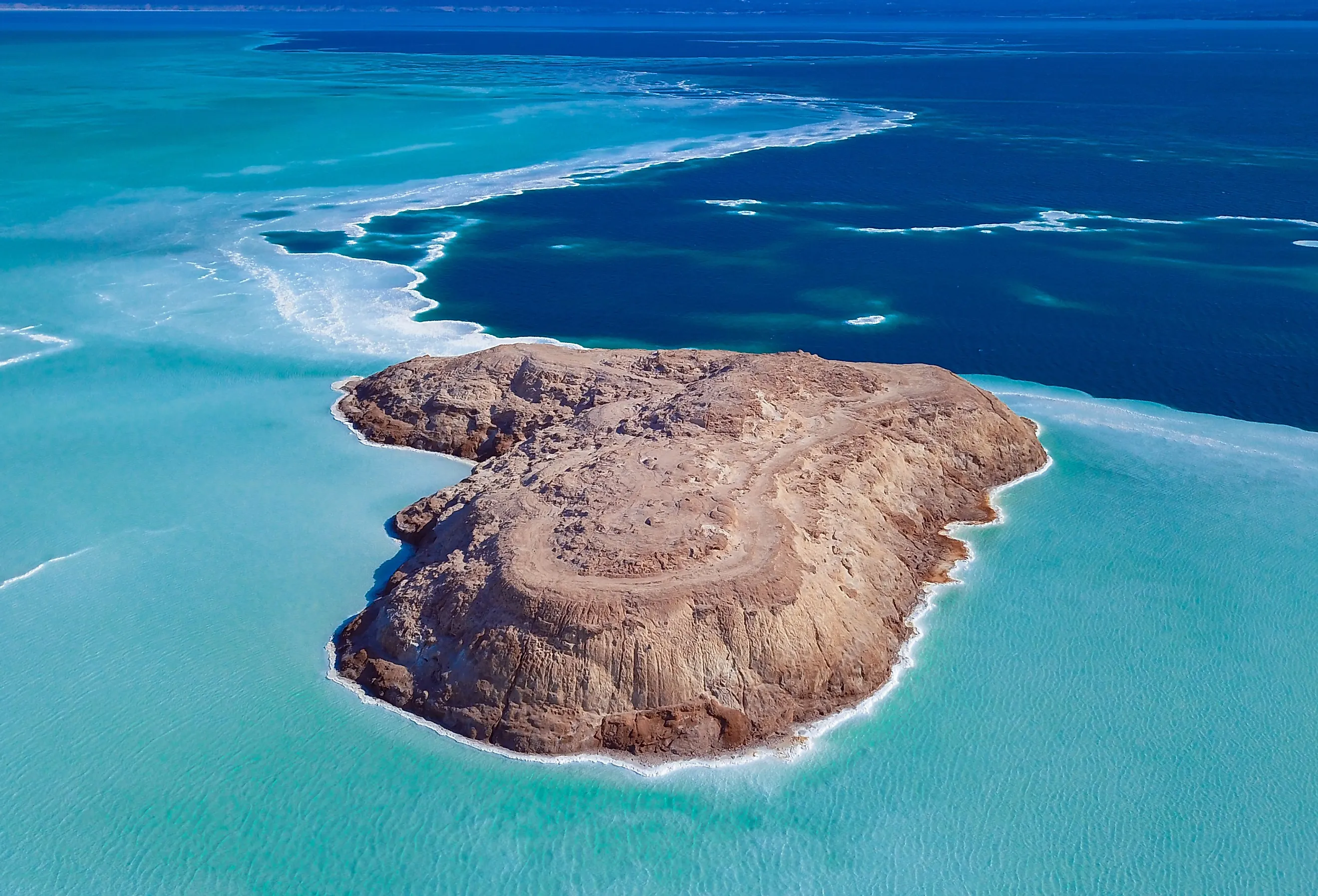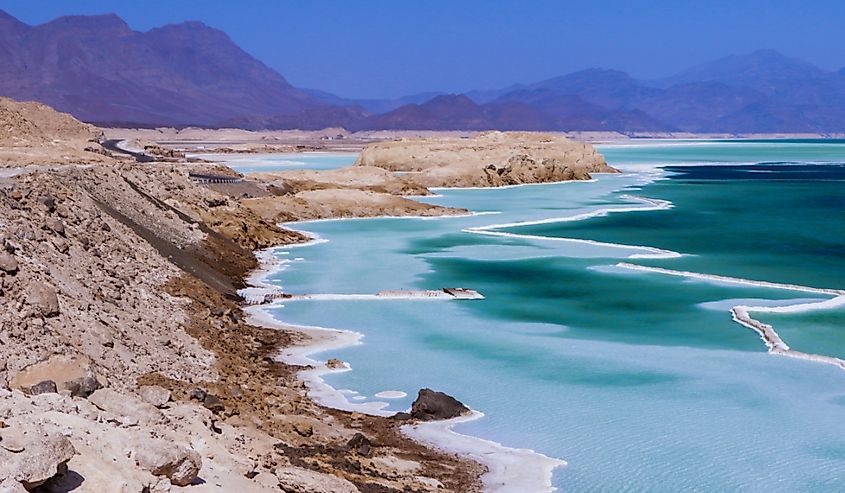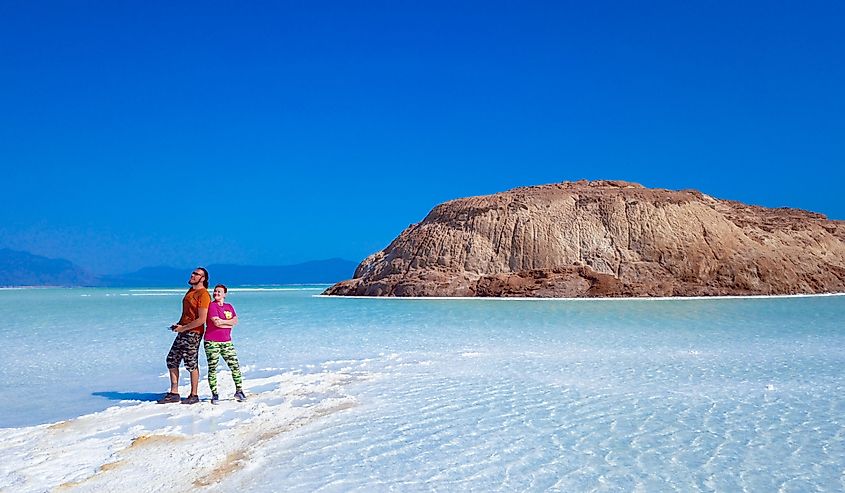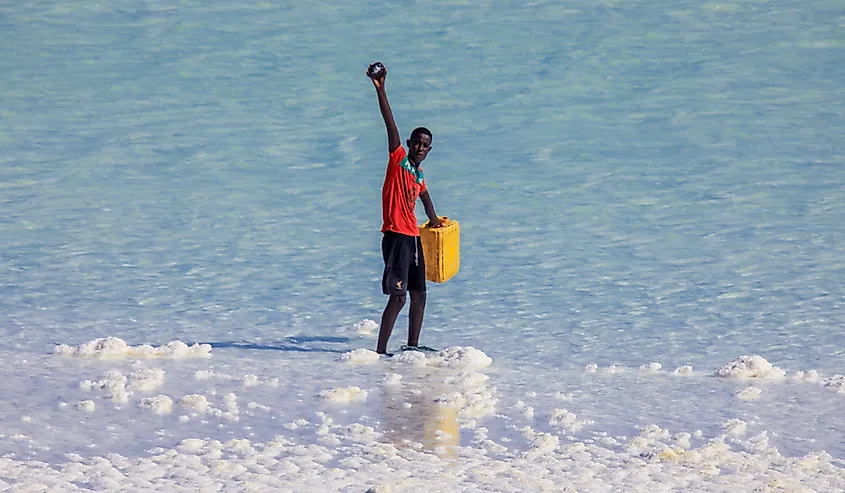
Lake Assal
While many lakes are full of marine flora and fauna, some lakes are too salty to allow marine life to thrive. This is the case for Lake Assal. This lake is one of the saltiest lakes in the world and is the lowest point in Africa. While inhabitable and too salty for very much human interaction, the beautiful green-blue waters and white shores of the lake have drawn curious people to the area for centuries. Lake Assal is not a Caribbean vacation for those looking for recreational water activities, however it does contain unique properties that can benefit humans!
Geography

Lake Assal is a unique crater, oval-shaped lake. The lake is in central-western Djibouti, at the western end of the Gulf of Tadjoura in the Tadjoura Region. It is on the northern end of the Great Rift Valley. The watershed area of the lake is 900 square kilometers. The lake is 19km long and 6.5km wide. At its deepest point, the lake is 40m deep, but the mean depth of the lake is less than half of that, at 7.4 m deep. There are two distinct parts of the lake, the dry part and the highly saline water body. The dry part of the lake is a result of the evaporation of the lake waters. This has left an exposed salt bed on the west-northwest side of the lake.
Lake Assal has no outflow point. All the lake water collects within the crater of the lake. Seawater from geothermal springs feeds into Lake Assal. The springs are 5km long, and linked to the Gulf of Tadjoura, on the southeastern side of Lake Assal. This is an extension of the Gulf of Aden.
As mentioned before, Lake Assal is the lowest point in Africa. It is 153 meters below sea level and ranks as the third lowest point in the world, after the Dead Sea and the Sea of Galilee. The lake is in one of the world's most inhospitable deserts. Inactive volcanoes surround the lake. Lava sediments lay around Lake Assal and are an intense black color, adding to its allure.
Looks Are Deceiving

At first glance, Lake Assal looks like a beautiful, typical Caribbean beach. The waters are a serene blue-green color, an incredible contrast to the blinding white sand. However, a walk on the beach will prove to be a painful lesson in not judging a book by its cover. What looks like sand is salt. While visitors here may be tempted to venture out and swim in the waters, this is ill-advised. The water has a strange viscous quality that leaves a film on the skin, due to its high salinity.
Lake Assal has a high evaporation rate which is the reason for the lake's saltiness. The average salt concentration of the lake is 34.8%. This amount reaches as high as 40% when the depth of the lake is 20m. Lake Assal is ten times saltier than the sea and is the second saltiest body of water in the world. The Don Juan Pond in Antarctica is the saltiest body of water in the world. The salinity level of Don Juan Pond is more than 47%.
Human Activity

Even though the salt in Lake Assal drives away many life forms, the Afar and Issa people have worked and lived in the area for centuries. The salt has been a source of economic prosperity for the region. Locals scrap and dig the lake's shore to get the salt. Caravans then transported the salt to Ethiopia and traded it for other goods, such as coal and coffee. In the past people traded salt for other commodities such as ivory and sometimes slaves.
During the Ethiopian-Eritrean War in 1998, Djibouti became Ethiopia's primary salt supplier. Since Ethiopia had such a large demand and a large population, it resulted in salt being an expensive commodity. This gave salt from Lake Assal the nickname 'white gold'. During this time, locals used heavier extraction methods to keep up with demand. Extracting salt on the shores by hand was not enough. Heavier machinery extracted larger pans of salt from the water and salt production in Lake Assal skyrocketed. Lake Assal previously produced thousands of tonnes of salt per year. After using the machinery, Lake Assal was able to produce hundreds of thousands of tonnes per year. This led to the area using increasingly modern methods to extract salt to export it globally. Today, people use both modern and traditional methods to extract the salt from Lake Assal. The region has also become a popular tourist destination to visit to witness the breathtaking shores of the lake.
Lake Assal's Future
Lake Assal is undeniably important for the local economy in Djibouti. Beyond exporting salt, the region has proposals to help boost tourism. There are proposals to build a visitor's center and develop a wellness resort, similar to the ones found on the coast of the Dead Sea. This is because of the supposed health benefits of the lake.
The water is high in other minerals that are good for the skin such as magnesium, calcium, and sulphates. These minerals can cleanse, soothe, and reinvigorate the skin. Minerals such as magnesium can also provide pain relief and are good for muscle or joint pain. While these are not benefits one can reach from a simple walk on Lake Assal's shores, they are health benefits a wellness resort could take advantage of. Considering the interest and opportunity for development on Lake Assal, the future of the region looks uncertain. The development of facilities such as a wellness resort in the area may open new economic opportunities for the region.











